GDP based on Purchasing Power Parity (PPP) is a measure that helps compare the economic strength of different countries by adjusting for the cost of living. This means it shows how much people can actually buy in their own country rather than just converting currencies. China has the highest GDP (PPP) at over $39 trillion, followed by the United States and India at $13 trillion and $17 trillion respectively. However, in terms of nominal GDP, the United States has the largest economy, followed by China.
Key Takeaways
- China has the highest GDP (PPP) at over $39 trillion, followed by the United States and India.
- Asia dominates the ranking with four countries, including China, India, Japan, and Indonesia among the largest economies by GDP (PPP).
- The total GDP based on purchasing power parity (PPP) of the top 10 nations amounts to approximately $126 trillion.
Top 10 Largest Economies with highest GDP (PPP)
The table below highlights the top 10 largest economies by GDP (PPP), measured in trillions of US dollars.
| Rank | Country | GDP (PPP) (Trillions of Intl $) |
|---|---|---|
| 1 | China | 39.44 |
| 2 | United States | 30.34 |
| 3 | India | 17.36 |
| 4 | Russian Federation | 7.13 |
| 5 | Japan | 6.77 |
| 6 | Germany | 6.17 |
| 7 | Indonesia | 4.98 |
| 8 | Brazil | 4.89 |
| 9 | France | 4.49 |
| 10 | United Kingdom | 4.42 |
The data is sourced from the International Monetary Fund.
1. 🇨🇳 China – GDP (PPP): $39.44 trillion
China has the largest GDP purchasing power parity (PPP) globally. It surpassed the United States as the world’s largest economy on the basis of GDP (PPP) in 2010. Rapid industrialization, urbanization, and massive manufacturing output are the primary factors that contributed to China’s high GDP (PPP).
Because of its high GDP (PPP), the cost of living in China is much lower than in developed countries. It means that people in China, on average, can afford more goods and services than those in many other countries, even though its currency may be weaker compared to others.
2. 🇺🇸 United States – GDP (PPP): $30.34 trillion
The United States is the 2nd largest economy on the basis of GDP measured at purchasing power parity (PPP). However, in terms of nominal GDP, it is the largest economy in the world. This remarkable high GDP, both nominal and PPP, is driven by the strong economy of the United States.
The primary sectors contribute to the U.S. high GDP include technology, finance, healthcare, and manufacturing. Additionally, the country boasts one of the highest labor productivities globally. It indicates that American workers can produce more goods and services per hour compared to their counterparts in many other countries.
Top 10 Poorest Countries in The World 2025
3. 🇮🇳 India – GDP (PPP): $17.36 trillion
India holds the third-largest GDP based on purchasing power parity (PPP). It also ranks among the top ten countries on the basis of nominal GDP. The country’s economic growth is fueled by a large population, high domestic consumption, and a strong service sector. Additionally, the country’s IT industry, agriculture, and manufacturing also play crucial roles in its development.
According to the International Monetary Fund (IMF), India is projected to grow approximately 6% in 2025 and it is one of the fastest-growing major economies.
4. 🇷🇺 Russia – GDP (PPP): $7.13 trillion
Russia holds the fourth-largest GDP on the basis of purchasing power parity (PPP). The country’s economy relies heavily on its abundant natural resources, such as Oil, gas, and minerals, which generate the bulk of its export earnings. In addition to the energy sector, Russia also has a strong industrial base and growing technology and defense sectors.
Despite facing sanctions and economic challenges due to its conflict with Ukraine, Russia remains an important country in the global economy.
5. 🇯🇵 Japan – GDP (PPP): $6.77 trillion
Japan holds the fifth-largest GDP based on purchasing power parity (PPP). After World War II, Japan’s economy bounced back positively and gradually became the world’s leading economy. Today, Japan is among the top ten largest economies worldwide by both nominal and PPP GDP. The economy of Japan is dominated by prominent sectors like technology, robotics, electronics, and car manufacturing.
Despite challenges such as an aging population, low fertility rate, and scarce natural resources, the nation still spends a large portion of its GDP on research and development. As a result, Japan remains an important country in international trade and ranks among the top economies globally.
6. 🇩🇪 Germany – GDP (PPP): $6.17 trillion
Germany is one of the founding members of the European Union and the eurozone. It has the largest economy in Europe and the third-largest in the world by nominal GDP. The country’s strong industrial base, especially in areas like motor vehicles and machinery, has been instrumental in its economic success.
Additionally, Germany invests more than 3% of its GDP in research and development, which reflects its focus on innovation. Due to its commitment to innovations, the country consistently ranks among the top nations in the Global Innovation Index.
The 10 Countries with the Highest Inflation Rates in 2025
7. 🇧🇷 Brazil – GDP (PPP): $4.98 trillion
Brazil is the seventh-largest economy by GDP (PPP) and tenth-largest by nominal GDP. It is also the largest economy in Latin America. The country is a major exporter of commodities such as soybeans, coffee, and iron ore. Between 2000 and 2012, it experienced rapid economic growth, with an average annual GDP increase of over 5%. Despite having a high GDP based on purchasing power parity (PPP), the country faces a high level of income inequality. In 2024, Forbes ranked Brazil as the 7th country with the most billionaires.
8. 🇮🇩 Indonesia – GDP (PPP): $4.89 trillion
Indonesia is the largest economy by GDP (PPP) in Southeast Asia and the eighth largest globally. As an upper-middle-income country and a G20 member, the country is expected to become the world’s 4th largest economy by 2045. Its lower cost of living compared to developed nations boosts its PPP value. Additionally, Indonesia is rich in natural resources, including oil, gas, coal, and minerals, which play an important role in boosting its exports. The country also became the first Southeast Asian nation to formally join BRICS in 2025.
9. 🇫🇷 France – GDP (PPP): $4.49 trillion
France is a major European economy which consistently ranks among the top ten nations in both nominal GDP and purchasing power parity (PPP). Its economy is driven by a strong services sector and major industries like aerospace and luxury goods. The country also has a high-quality infrastructure which makes it a perfect destination for international investors.
Additionally, the country has a strong tourist sector and is the most visited country in the world. In 2020, France was ranked among the top 10 most innovative countries globally by the Bloomberg Innovation Index. In 2024, it ranked 12th out of 133 economies on the Global Innovation Index (GII). This innovation and its commitment to technological development make France one of the biggest economic powers in the European Union and globally.
The 10 Most Indebted Countries by Debt-to-GDP Ratio in 2025
10. 🇬🇧 United Kingdom – GDP (PPP): $4.42 trillion
The United Kingdom is one of the world’s largest and most developed economies. Its economy is mainly driven by a strong service sector, which accounts for about 80% of its GDP. London serves as a country’s major financial center, which attracts massive investment globally. Although the UK’s productivity growth has slowed recently, the country still maintains a high level of output per worker compared to many other countries.
Next 15 Largest Economies By GDP (PPP)
The table below highlights the next 15 largest economies by GDP (PPP), measured in trillions of international dollars.
| Rank | Country | GDP (PPP) (Trillions of Intl $) |
|---|---|---|
| 11 | Italy | 3.69 |
| 12 | Türkiye, Republic of | 3.61 |
| 13 | Mexico | 3.41 |
| 14 | Korea, Republic of | 3.39 |
| 15 | Spain | 2.77 |
| 16 | Canada | 2.69 |
| 17 | Egypt | 2.37 |
| 18 | Saudi Arabia | 2.25 |
| 19 | Poland | 1.99 |
| 20 | Australia | 1.97 |
| 21 | Taiwan Province of China | 1.93 |
| 22 | Thailand | 1.86 |
| 23 | Bangladesh | 1.8 |
| 24 | Iran | 1.78 |
| 25 | Vietnam | 1.76 |
Conclusion
GDP (PPP) is an important economic indicator which offers a more accurate comparison of living standards and economic productivity between countries. This is why nations like Indonesia, which do not rank among the top 10 countries by nominal GDP, still rank highly based on GDP (PPP). Additionally, China holds the top spot in GDP measured at purchasing power parity, followed by the United States and India.

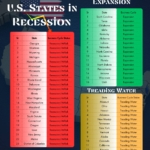
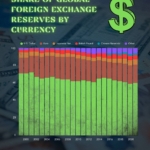



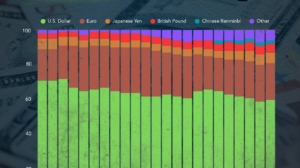


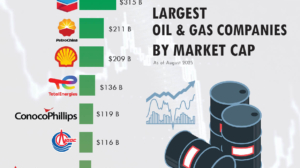
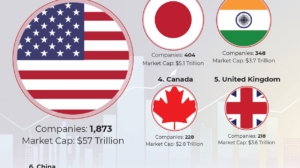
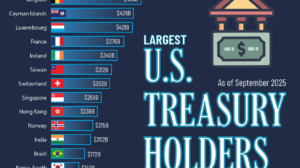
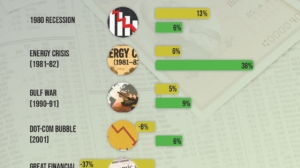
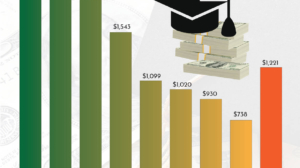
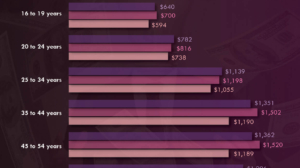
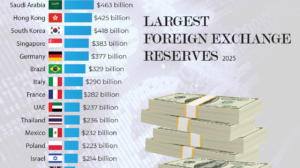
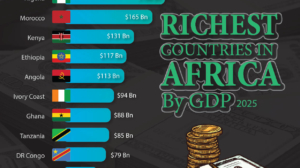
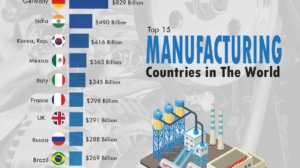
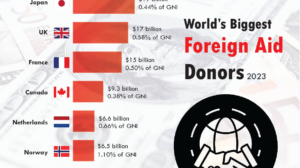
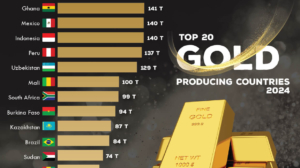
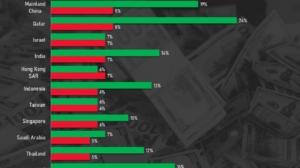
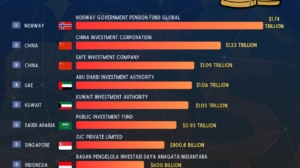
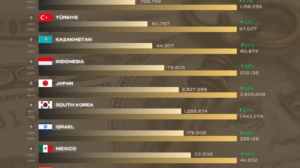

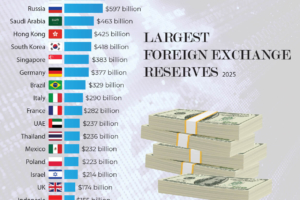
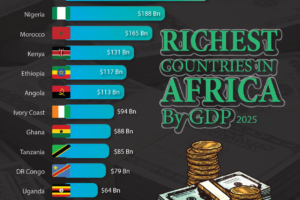
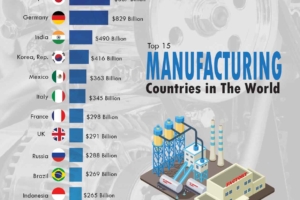








Add Comment